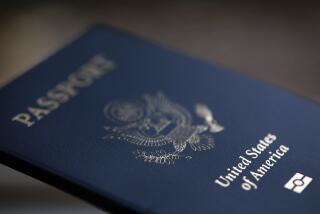Everything you need to know about passport rules
- Share via
Confused about passports and visas? No wonder. Countries set their own policies, so you may face different rules at each border you cross. Adding to the complexity, the United States has been changing the requirements for travel to Mexico, Canada, the Caribbean and Bermuda.
Here’s what you need to know about these vital documents. The most complete information is at the State Department’s website, travel.state.gov in the “Passports for U.S. Citizens” section.
Question: Does the U.S. require a passport to visit Mexico, Canada, the Caribbean or Bermuda?
Answer: Yes and no. It depends on how you go.
If you fly, you need a passport. If you travel by land or sea, you don’t. But as of Jan. 31, U.S. adults are expected to present at least a birth certificate or other proof of citizenship, plus a government-issued photo ID, such as a driver’s license, to cross these land-sea borders; children 18 and younger need only a birth certificate.
Starting sometime this spring, the State Department plans to issue a new document, called a passport card, that you can use for land-sea crossings from Mexico, Canada, the Caribbean and Bermuda.
The law notwithstanding, some cruise lines may ask you to carry a passport. Because a passport is good for all types of border crossings, it makes sense to get one if you plan to travel outside the United States.
For updates on U.S. regulations, visit the websites of the Department of Homeland Security, www.dhs.gov, and the State Department, www.travel.state.gov.
Q: Do I need a passport to visit foreign destinations other than Canada, Mexico, the Caribbean and Bermuda?
A: Yes. These rules haven’t changed.
Q: Do I need a passport to travel to or return from a U.S. territory, such as Puerto Rico, the U.S. Virgin Islands or Guam?
A: No. Those rules haven’t changed.
Q: How do I apply for a passport, and how much does it cost?
A: In general, if it’s your first passport, or your old one has expired and was issued more than 15 years ago, you’ll need to apply in person at a post office, public library or other government office authorized to receive applications.
There are thousands of these places, searchable by ZIP Code on www.travel.state.gov. Don’t go to a regional passport agency; these deal with last-minute requests and other emergencies and can be visited by appointment only.
Besides filling out an application form, which you can download from the website, you must bring a government-issued photo ID; a birth certificate or other proof of U.S. citizenship; two current photos of yourself; and the required fee. The specifications for the photos, found on the State Department website, are quite specific.
If you just need to renew your passport, you don’t have to appear in person; you can complete this process by mail.
Fees are $97 for your first passport and $67 for renewals. Passports are good for 10 years.
Different rules and fees apply to children. See the website for details.
Q: My passport expires in four months. Can I still travel on it?
A: That depends on the country. Some require that you have at least six months left on your passport. Because policies can change, the safest option is to get a new passport.
Q: I have one blank page left in my passport booklet. Is that enough?
A: That also depends on the country. Some won’t let you enter unless you have at least two to four blank pages for visa stamps, according to the State Department.
Q: How long does it take to get a passport?
A: Currently it takes about four to six weeks, the State Department says. That’s a big change from last year, when a crush of passport applications caused backlogs of 12 weeks or more, thwarting many vacation plans.
To avoid a last-minute panic, it’s smart to apply far ahead of your planned departure. Problems can occur. For instance, if you make a mistake on your application, such as submitting a photo that is too small or sending the wrong fee, the State Department may reject it and mail it back to you. Then the clock starts over.
Q: Can I do anything to speed things up?
A: Maybe. You can request “expedited service,” which the State Department says will get the passport to you within three weeks. The fee is $60, in addition to the regular application fee.
Another option is to entrust your application to a private expediting service. This isn’t cheap -- it can cost $100 and up, plus the government’s expediting fee -- and it’s no guarantee. But these companies have standing appointments at passport agencies, which gives them a better shot at pushing through applications.
One way to find an expediter is to visit www.napvs.org, the website of the National Assn. of Passport & Visa Services. The website links to its members, which include many of the bigger companies.
Q: How do I check the status of my application?
A: You can do this online at the State Department’s website. But the information may not show up immediately. You can also send an e-mail, but responses may take several days.
Q: What should I do if I’m due to leave for my trip within two weeks and I don’t have my passport?
A: The State Department advises that you call for an appointment at a regional passport agency -- if you’re lucky enough to live near one. There are more than a dozen in the U.S., mostly in big cities. The toll-free phone is (877) 487-2778.
If you haven’t yet applied for your passport, you could pay a private expediting service (see above) to handle your case. But if you’ve already applied, your documents are in transit, so an expediter may not be able to help.
As a last resort, some Los Angeles Times readers say they have been helped by their congressional representative. Members of Congress get a special phone line into the passport agency, and they typically have close working relationships with the local passport office.
Q: Do I need a visa, and how do I get one?
A: That depends on where you’re going. Many countries in Africa, Asia, the Middle East and the former Soviet Union require U.S. visitors to get visas. By contrast, Canada, Mexico and many nations in Europe, Latin America, the Caribbean and other places that get lots of American visitors don’t require visas.
Although the State Department offers visa guidance at www.travel.state.gov (click on “Country Specific Information,” then choose your destination), your best source is the embassy or consulate of the country you plan to visit. Policies change often.
To get a visa, you typically send your passport, visa application and a fee to the embassy or consulate of the foreign country that you’re traveling to. Many applicants get their visas in two weeks or less, but to be safe, allow at least a couple of months, experts advise.
A travel agent or tour operator can often help with visas for trips that you book with them. You can also pay a private visa service to handle the details. Among major ones are Zierer, www.zvs.com, and Travisa, www.travisa.com. Fees vary.
More to Read
Sign up for The Wild
We’ll help you find the best places to hike, bike and run, as well as the perfect silent spots for meditation and yoga.
You may occasionally receive promotional content from the Los Angeles Times.






